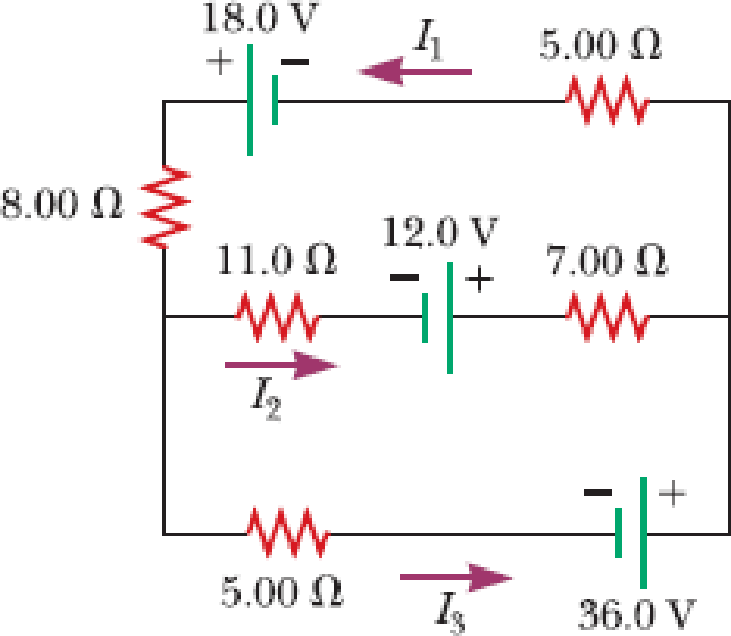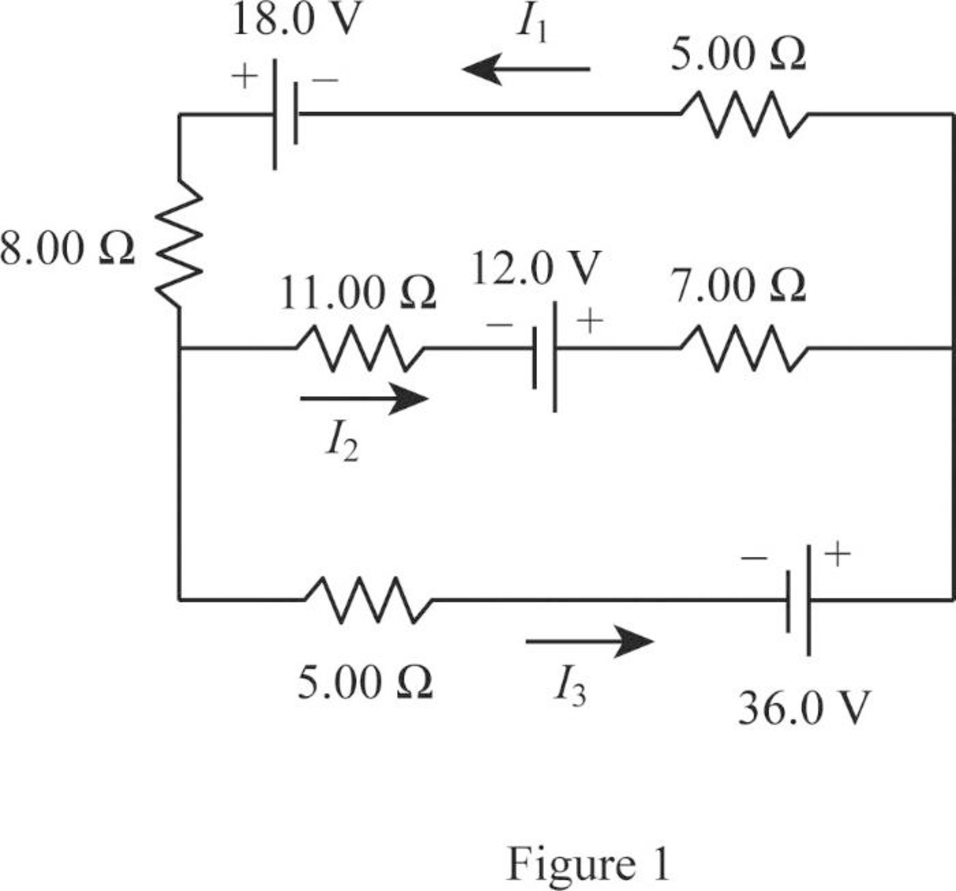
For the circuit shown in Figure P21.50, we wish to find the currents I1, I2, and I3. Use Kirchhoff’s rules to obtain equations for (a) the upper loop, (b) the lower loop, and (c) the junction on the left side. In each case, suppress units for clarity and simplify, combining the terms. (d) Solve the junction equation for I3. (e) Using the equation found in part (d), eliminate I3 from the equation found in part (b). (f) Solve the equations found in parts (a) and (e) simultaneously for the two unknowns I1 and I2. (g) Substitute the answers found in part (f) into the junction equation found in part (d), solving for I3. (h) What is the significance of the negative answer for I2?
Figure P21.50

(a)
The equations for the upper loop in the circuit diagram.
Answer to Problem 50P
The equation for the upper loop is
Explanation of Solution

Write the expression for the Kirchhoff’s loop rule for the upper loop going counter clockwise.
Conclusion:
Therefore, the equation for the upper loop is
(b)
The equations for the lower loop in the circuit diagram.
Answer to Problem 50P
The equation for the lower loop is
Explanation of Solution
Write the expression for the Kirchhoff’s loop rule for the lower loop going counter clockwise.
Conclusion:
Therefore, the equation for the lower loop is
(c)
The equation of the junction on the left side in the circuit diagram.
Answer to Problem 50P
The equation of the junction in the left side is
Explanation of Solution
Write the expression for the Kirchhoff’s junction rule for the junction on the left side in the circuit.
Conclusion:
Therefore, the equation of the junction in the left side is
(d)
The equation for
Answer to Problem 50P
The equation for
Explanation of Solution
Use equation (III) to solve for
Conclusion:
Therefore, the equation for
(e)
The equation of the lower loop without using
Answer to Problem 50P
The equation of the lower loop without using
Explanation of Solution
Use equation (IV) in (II) to solve for the lower without using
Conclusion:
Therefore, the equation of the lower loop without using
(f)
The value of current
Answer to Problem 50P
The value of current
Explanation of Solution
Use equation (V) to solve for
Use equation (VI) in (I) to solve for
Use equation (VII) in (I) to solve for
Conclusion:
Therefore, the value of current
(g)
The value of current
Answer to Problem 50P
The value of current
Explanation of Solution
Use equation (VIII) and (VII) in (IV) to solve for
Conclusion:
Therefore, the value of current
(h)
The significance of negative sign in the current
Answer to Problem 50P
The negative sign for
Explanation of Solution
The negative sign in the value of the current
Conclusion:
Therefore, the negative sign for
Want to see more full solutions like this?
Chapter 21 Solutions
Principles of Physics: A Calculus-Based Text, Hybrid (with Enhanced WebAssign Printed Access Card)
- Which of the following best describes how to calculate the average acceleration of any object? Average acceleration is always halfway between the initial acceleration of an object and its final acceleration. Average acceleration is always equal to the change in velocity of an object divided by the time interval. Average acceleration is always equal to the displacement of an object divided by the time interval. Average acceleration is always equal to the change in speed of an object divided by the time interval.arrow_forwardThe figure shows the velocity versus time graph for a car driving on a straight road. Which of the following best describes the acceleration of the car? v (m/s) t(s) The acceleration of the car is negative and decreasing. The acceleration of the car is constant. The acceleration of the car is positive and increasing. The acceleration of the car is positive and decreasing. The acceleration of the car is negative and increasing.arrow_forwardWhich figure could represent the velocity versus time graph of a motorcycle whose speed is increasing? v (m/s) v (m/s) t(s) t(s)arrow_forward
- Unlike speed, velocity is a the statement? Poisition. Direction. Vector. Scalar. quantity. Which one of the following completesarrow_forwardNo chatgpt pls will upvote Already got wrong chatgpt answerarrow_forward3.63 • Leaping the River II. A physics professor did daredevil stunts in his spare time. His last stunt was an attempt to jump across a river on a motorcycle (Fig. P3.63). The takeoff ramp was inclined at 53.0°, the river was 40.0 m wide, and the far bank was 15.0 m lower than the top of the ramp. The river itself was 100 m below the ramp. Ignore air resistance. (a) What should his speed have been at the top of the ramp to have just made it to the edge of the far bank? (b) If his speed was only half the value found in part (a), where did he land? Figure P3.63 53.0° 100 m 40.0 m→ 15.0 marrow_forward

 Principles of Physics: A Calculus-Based TextPhysicsISBN:9781133104261Author:Raymond A. Serway, John W. JewettPublisher:Cengage Learning
Principles of Physics: A Calculus-Based TextPhysicsISBN:9781133104261Author:Raymond A. Serway, John W. JewettPublisher:Cengage Learning Physics for Scientists and Engineers, Technology ...PhysicsISBN:9781305116399Author:Raymond A. Serway, John W. JewettPublisher:Cengage Learning
Physics for Scientists and Engineers, Technology ...PhysicsISBN:9781305116399Author:Raymond A. Serway, John W. JewettPublisher:Cengage Learning College PhysicsPhysicsISBN:9781305952300Author:Raymond A. Serway, Chris VuillePublisher:Cengage Learning
College PhysicsPhysicsISBN:9781305952300Author:Raymond A. Serway, Chris VuillePublisher:Cengage Learning College PhysicsPhysicsISBN:9781285737027Author:Raymond A. Serway, Chris VuillePublisher:Cengage Learning
College PhysicsPhysicsISBN:9781285737027Author:Raymond A. Serway, Chris VuillePublisher:Cengage Learning College PhysicsPhysicsISBN:9781938168000Author:Paul Peter Urone, Roger HinrichsPublisher:OpenStax College
College PhysicsPhysicsISBN:9781938168000Author:Paul Peter Urone, Roger HinrichsPublisher:OpenStax College





